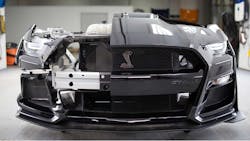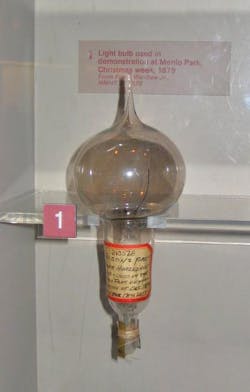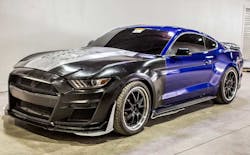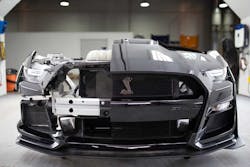At a Glance:
- Whether high tech or low tech, prototyping comes in many forms. The process is typically iterative, nonlinear and automated.
- Protolabs is automating the additive manufacturing production process through an integrated lifecycle e-commerce platform.
- Ford joined rivals GM and Fiat Chrysler in using their manufacturing might to make fast prototypes for personal protective equipment during the COVID-19 outbreak.
- Pipeline Design & Engineering favors a nonlinear prototyping style that emphasizes building a well-defined list of functional requirements for medical device machines under development.
Thomas Edison didn’t invent the lightbulb, but his work in prototyping the first incandescent lighting system is a classic example of trial and error.
The prolific inventor sent people to the far reaches of Africa and Japan in search of satisfactory filament material, and it would take more than 1,200 experiments, 6,000 specimen plants and $40,000 to unveil the prized incandescent electric lightbulb. That prototype (U.S. patent 223,898), with its filament of carbonized sewing thread, burned for 13.5 hours and lit up his entire Menlo Park industrial research laboratory.
On the one hand, Edison’s inventions—he was issued a total of 1,093 patents—are the consummate endorsement for rapidly iterating to get it right. On the other, few manufacturing companies have the luxury of making countless mistakes in today’s fiercely competitive, faster, better, cheaper marketplace.
Shuffle the Offerings
Nowhere was the need for rapid prototyping more relevant than when personal protective equipment such as N95 masks were in short supply at the start of the coronavirus outbreak last year.
Will Martin, director of marketing and communications at Protolabs, proudly tells the backstory of the B2 respirator. Named among Time’s best inventions of 2020, the B2 was a redesign of a prototype that mechanical design engineer Max Bock-Aronson conjured up back in 2013 to combat air pollution, Martin said. Protolabs supported Bock-Aronson’s startup, Breathe99, by developing the machine-washable respirator’s filter cups, faceplate substrate and filter cap that remove 99% of contaminants.
Bear in mind that Ford’s supercomputers and state-of-the-art 3D printing capabilities eclipse common-practice production standards. Low-volume production in the automotive industry could mean anything from lot size one to up to tens of thousands of units, and it explains why the automaker’s high-performance division designers, powertrain and aerodynamics engineers could rely on state-of-the-art AM prototyping tools to unleash the ultimate performance street-legal Mustang Shelby GT500 in 2020.
For an execution of this caliber, every millimeter would have to count to deliver on downforce, braking and cooling targets. Development time was sped up and the most promising designs were printed in a matter of days. Aerodynamic refinements were made, and to increase the fidelity of performance, simulations had to work in lockstep with physical validations at Ford’s wind tunnels in Michigan and Windshear rolling wind tunnel in Concord, said Lee.
“Delivering more than 700 horsepower using 93-octane fuel, maximizing cooling at the front is critical to the Shelby GT500’s vigorous track performance,” stated Ford’s press note at the time. “At wide-open throttle, the cooling system needs to extract up to 230 kilowatts of heat energy, enough to heat a dozen homes. The massive front brakes reject another 100 kilowatts of heat at maximum braking, so the team utilized advanced 3D airflow modeling to maximize overall cooling while working to minimize impact on front-end lift and drag.”
At the time of the launch Ford could boast that the design team triumphed by achieving maximum rear downforce of 550 lb at 180 mph, leveraging the Mustang GT4 race-proven rear track wing to deliver the most downforce ever on a street-legal Mustang. As for the supercar’s rear spoiler design, dubbed “the swing,” advanced simulations and prototyping processes were responsible for making the vehicle deliver 379 lb of rear downforce at 180 mph.
Since the braking system of the Shelby performance vehicle is distinct from the base model, a new design for this particular part was needed. Lee said Ford was able to convert from a metal part to a plastic part with over 60% reduction in weight, and was able to reduce complexity in the design of the original model, which consisted of a left-handed and a right-handed bracket.
Unlike traditional tooling processes, AM design tools allowed engineers to consolidate the part from three parts to one “ambidextrous” part, which could be used either on the driver or passenger side of the vehicle and reduced complexity and assembly. “We had significant cost savings compared to tooling this part,” Lee said.
Editor's Note: Machine Design's Women in Science and Engineering (WISE) hub compiles our coverage of gender representation issues affecting the engineering field, in addition to contributions from equity seeking groups and subject matter experts within various subdisciplines. Click here for more.
About the Author

Rehana Begg
Editor-in-Chief, Machine Design
As Machine Design’s content lead, Rehana Begg is tasked with elevating the voice of the design and multi-disciplinary engineer in the face of digital transformation and engineering innovation. Begg has more than 24 years of editorial experience and has spent the past decade in the trenches of industrial manufacturing, focusing on new technologies, manufacturing innovation and business. Her B2B career has taken her from corporate boardrooms to plant floors and underground mining stopes, covering everything from automation & IIoT, robotics, mechanical design and additive manufacturing to plant operations, maintenance, reliability and continuous improvement. Begg holds an MBA, a Master of Journalism degree, and a BA (Hons.) in Political Science. She is committed to lifelong learning and feeds her passion for innovation in publishing, transparent science and clear communication by attending relevant conferences and seminars/workshops.
Follow Rehana Begg via the following social media handles:
X: @rehanabegg
LinkedIn: @rehanabegg and @MachineDesign




